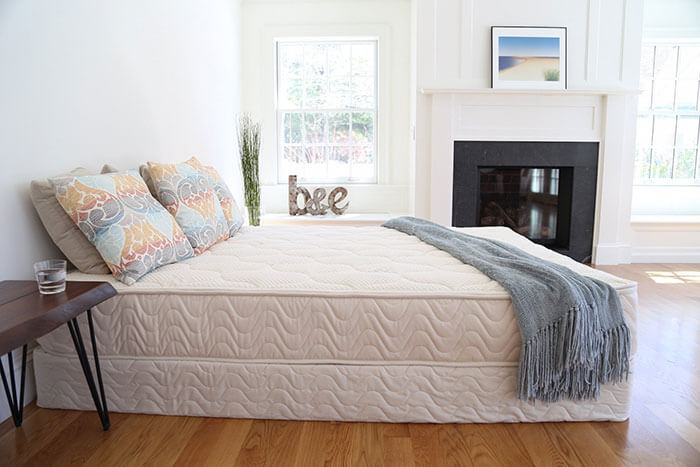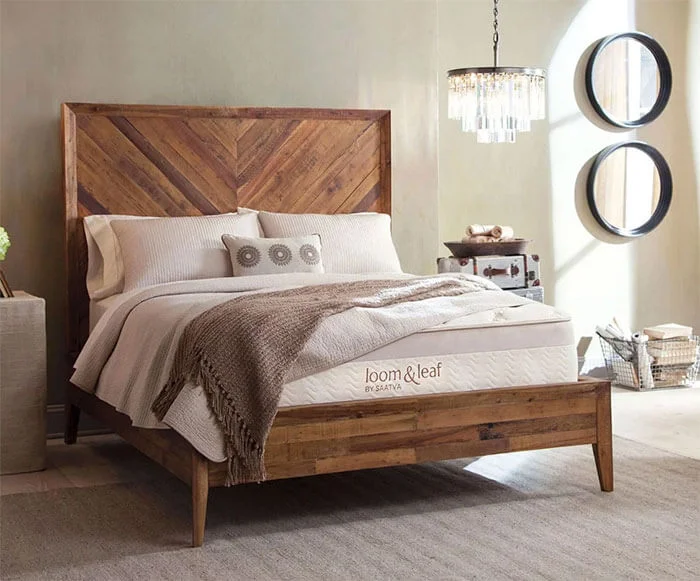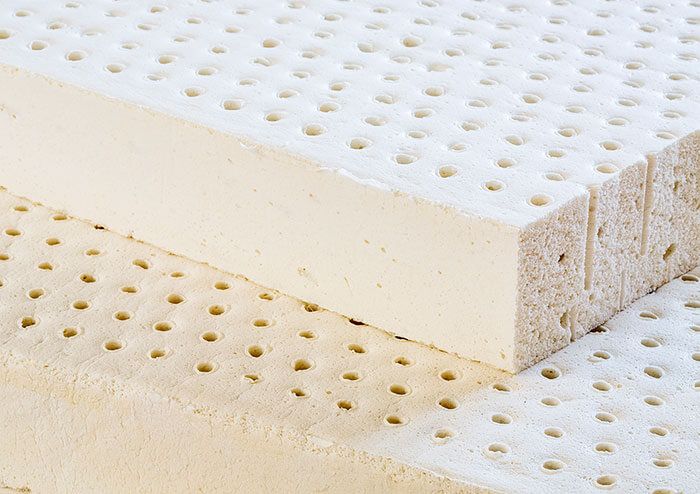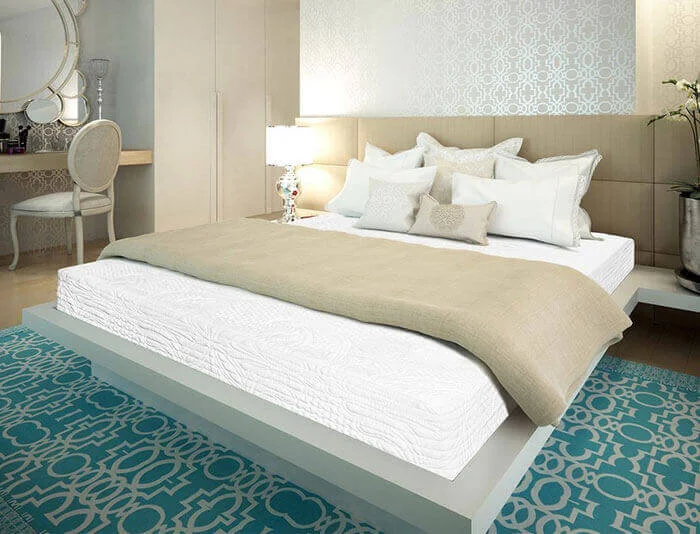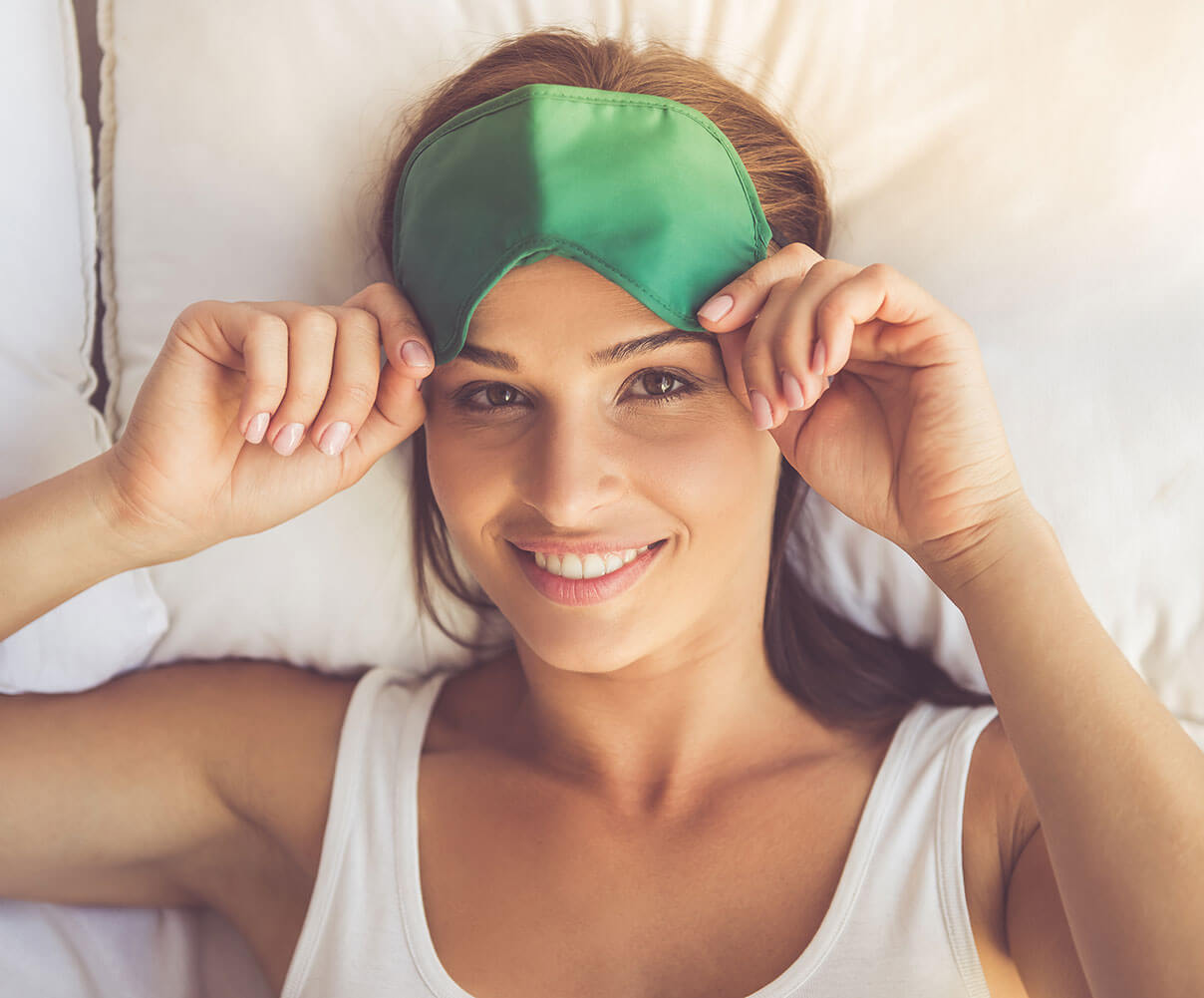Compare Latex vs Memory Foam Mattress That’s Ideal For You
Over the years, memory foam has seen quite a history. From its beginnings as part of the American space program to its eventual transformation into one of the most comfortable, healthy mattress materials on the market, memory foam is as versatile as it is practical. The material has applications in science, medicine, athletics and even footwear. In addition to its hundreds of uses, memory foam has evolved to a point where there are several types of materials on the market. You can choose from memory foam, gel memory foam, regular foam and even latex foam.
Latex and Memory Foam Guide contains:
Latex vs memory foam
Dunlop vs Talalay
Memory Foam vs Gel Memory Foam
How memory foam is made
How latex is made
If you’re beginning to shop for a new mattress, you may be wondering which type of memory foam is best for you. You may even be confused as to what, exactly, memory foam is. This guide will help you navigate the world of memory foam mattresses, allowing you to choose the type of mattress that’s ideal for you and your family.
While upgrading your bedroom with eco-friendly touches, explore Affordable Organic Mattresses, Pillows, Mattress Toppers and Protectors.
In What Products Will You Find Memory Foam?
Memory foam isn’t just made for mattresses. In fact, the material is so springy and comfortable that you’ll find memory foam used in a very broad range of products. Initially, memory foam was very expensive to produce. Frankly, many manufacturers and businesses just didn’t want to deal with it. Eventually, however, new methods of production were introduced and it became more feasible to use memory foam in everyday applications.
Today, you’ll find memory foam at the mattress store, of course. However, you may be surprised to learn that the foam is also used in the manufacture of sports helmets, children’s car seats, pillows and even bath mats. You may have owned a pair of shoes with memory foam insoles, or perhaps you know someone who uses a wheelchair with memory foam cushions. Needless to say, as the price to produce memory foam has decreased, the products that incorporate the material have increased.
Memory Foam: A History
There’s no doubt about it: memory foam has become quite popular. Most commonly consumers choose memory foam beds to sleep on. However, there are many other applications which use the material, ranging from shoes to hospital equipment. How did memory foam become so popular? Let’s take a look at the history of memory foam.
The Early Days of Memory Foam
NASA Memory Foam
The Early Days of Memory Foam: NASA
Many people don’t know that memory foam was created by NASA in 1966. The objective was to improve the safety of aircraft, in particular aircraft cushions. The foam they created was not used for sleep, but to lessen the impact on astronauts of G forces experienced in takeoff, flight and landing. The “formula” for NASA memory foam was released to the public in the 80’s, but there were few companies that were willing to work with the material. It was difficult to produce in a uniform way, and was quite expensive to make as well. An important industry that caught on to the benefits of memory foam was the healthcare industry. It became apparent that the material was excellent for bed-ridden patients. Lying on a memory foam mattress was shown to improve blood circulation, reducing the instance of gangrene significantly.
Memory foam was also shown to alleviate discomfort for joint pain sufferers as well as those with fibromyalgia. As medical research and advancements continued, it eventually became more affordable to produce the material and other industries soon caught on to the benefits of memory foam. Today, manufacturers have devised many ways to make memory foam accessible to the consumer. Research and development teams have created ways to allow the material to better distribute heat, to reduce odor and, of course, to make memory foam more comfortable and durable.
The Origin of Latex Foam
In 1920s Birmingham, UK, there resided a chemist named Edward A. Murphy. Murphy worked with Dunlop as a researcher, and one day the man was inspired to try something new. Taking his wife’s cake mixer, Murphy whipped up a batch of latex, producing a springy material that bounced back to its original shape easily. After about five years of trial and error, Dunlop and Murphy partnered to market Dunlopillo latex foam. The foam was used in aircraft as well as seating for public transportation and even the seats in the UK’s Houses of Parliament.
Around 1931, the first latex mattress was offered to the public. Consumers loved the soft Dunlopillo mattress, and also its ability to resist bed bugs. A low-maintenance bed, the Dunlopillo mattress never needed to be fluffed up or flipped over, making it appealing to homemakers. Today’s latex mattresses obviously aren’t created in cake mixers. However, the beds are still allergen-resistant, odor-resistant and easy to maintain. Made from natural materials, these beds are also sustainable and eco-friendly.
The Memory Foam Manufacturing Process
Not all memory foams are created in the same way. Just as there are many types of memory foam mattresses, there are also many ways of producing the material. The method of production depends largely on the type of foam. In this article, we’ll look at several types.
How Memory Foam is Made
Memory foam is largely made from synthetic materials which are perfect for latex allergy sufferers. While the “ingredients” of your memory foam mattress aren’t 100% naturally derived, don’t worry: these synthetic foams can still be made in a way that’s eco-friendly and safe for your family. We’ll talk more about memory foam’s eco-impact in a later section. Memory foam is created by combining alcohols with organic compounds and a reacting agent. Immediately prior to the manufacture of your mattress, these ingredients are mixed together, then whipped up into a frothy substance which is then poured into a mold. As the mixture sets, a heat reaction occurs, which causes the solution to bubble and expand, producing a foamy material.
After this initial “bubbling,” the firmness of your mattress is going to be determined. Manufacturers will infuse your mattress material with gas to create the desired density. Alternatively, for an open cell structure, the mixture can be vacuum sealed to create an open cell structure. After infusion, the foam is cooled, heated again, and left to cool once more. This cures the product, making it no longer reactive and almost ready to use. All that’s left is one final pass to remove remaining residues, and the finished product can be inspected and cut into mattress-sized pieces, ready to be assembled in layers if necessary, then shipped to your home. This, of course, is just a general overview of how memory foam is made. As you may know, memory foam mattresses may be infused with gel, can be aerated, can be a variety of densities and can even be infused with charcoal. Foam can be reticulated to open cells for better breathability. It can even have channels cut into it for increased air flow.
In the end, the memory foam mattress you choose will depend on your sleep style and preferences. We’ll look more at your memory foam options in a later section.
How Latex Foam is Made
More and more, consumers have begun to choose latex foam mattresses for their homes and families. This is in part because latex foam is created from natural rubber, is usually sustainably sourced, and has a relatively small eco-footprint. Again, that’s not to say that memory foam mattresses are, by definition, harmful to the environment. Not at all! However, consumers do love the natural properties of latex foam. There are two frequently used methods of producing latex foam. The first is the Dunlop Process. The second is the Talalay Process. Both processes can be performed using either natural or synthetic latex, so be sure you’re familiar with what the manufacturer has chosen.
The Dunlop Process
First, let’s look at the Dunlop Process. In the Dunlop process, your latex rubber will be combined with a few other trace ingredients in a centrifuge. It’s then whipped to a froth, similar to the method Edward A. Murphy used all those years ago! Catalysts are added to help set the mixture. Once the mixture is sufficiently frothy and the catalysts are put to work, the mixture is poured into a mold, capped and heated to around 350 degrees Fahrenheit. This cures the foam, but in the meantime, sediment will sink to the bottom of the mixture. This creates a slightly inconsistent feel; nearly all Dunlop mattresses are slightly firmer at the bottom than at the top.
This inconsistency shouldn’t be viewed as a downside to Dunlop mattress. In some cases, the extra support provided by the Dunlop method is ideal for back sleepers and those who want a little more firmness in a mattress. You’re less likely to “sink into” a Dunlop mattress. Additionally, the Dunlop process has a very small eco-footprint, making it one of the best manufacturing methods for the planet.
The Talalay Process
Next, let’s explore the Talalay Process of creating a latex foam mattress. The Talalay method is similar to the Dunlop method in that your natural or synthetic latex is whipped and molded. However, after the mixture is poured into a mold, it’s placed into a vacuum chamber where the air is extracted. The process of vacuum sealing the latex foam mixture causes the air bubbles in the product to expand. Then, to prevent inconsistencies in the foam, the mixture is flash frozen to about 20 degrees below 0. The flash freezing process keeps materials in the foam from settling, creating a consistent, durable product.
Once the flash freezing process is complete, the foam is heated to 200 degrees Fahrenheit then allowed to cool. The mattress that’s produced via the Talalay method is airy, lightweight and breathable. It’s ideal for people who sleep hot, as the open cell structure of the material allows for more air circulation than Dunlop foams provide. Consumers choose Talalay mattresses when they prefer a softer, more pillow-like feel. Talalay foams are great for those who suffer from joint pain, as well as those who just prefer a bit of a “hug” while they rest. However, do remember that the Talalay method has a larger environmental and water footprint than the Dunlop method.
Dunlop vs Talalay: Which Should You Choose
If you’re looking for a lighter, bouncier and airier mattress, a Talalay bed may be a great choice for you. If you prefer a firmer and more supportive feel, a Dunlop is a good option. However, do note that you don’t have to choose! Many latex foam mattresses are made by layering both Dunlop and Talalay foams. The firm support of the Dunlop mattress is incorporated into your mattress as a support core, or a base. Then, the mattress is layered with cooling Talalay to give you a soft, cool sleep surface. As you shop for a mattress, make note of the manufacturing process of your latex foam. Your mattress manufacturer should provide a clear indication of what each layer of your bed consists of, as well as the firmness rating of the latex foam.
Memory Foam Mattresses
We’ve explored the history of memory foam a bit, and have talked about the manufacturing process. If you’re interested in buying a traditional memory foam mattress, you may still have a few questions. Let’s look a little more comprehensively at traditional memory foam. The first question many people have when researching memory foam is whether the material is harmful to health or the environment. Since traditional memory foam is usually made from synthetic materials, it’s important to pay close attention to the certifications a mattress holds. CertiPUR-US and OEKO-TEX are two of the most well-known third parties responsible for certifying memory foam mattresses. There are several things these organizations look for when approving a memory foam mattress, including formaldehyde, heavy metals, Azo colorants and phalates among others.
Additionally, the organizations will certify a mattress based on its impact on the environment. Ozone depletion, VOCs, the effect of a foam on indoor air quality and overall emissions are several of the standards set by CertiPUR-US and OEKO-TEX. In short, if you’re buying a memory foam mattress that’s been certified by OEKO-TEX or CertiPUR-US, you can rest assured that your bed is safe for the planet, for your health and for your family. Look for the CertiPUR-US or OEKO-TEX labels on the mattress you choose. Now, is a memory foam mattress right for you? Memory foam mattresses are versatile in firmness, and can be as firm or plush as you choose. There are dozens of benefits to choosing a memory foam mattress, including pressure point relief, assistance in aligning your spine while you sleep and motion isolation.
Memory foam mattresses are more dust-mite resistant and hypoallergenic than traditional innerspring mattresses, which makes them great for those with allergies or respiratory issues. The mattresses are durable, easy to care for and there’s no flipping required. In addition, if you have (or need) an adjustable bed, memory foam mattresses are the perfect fit. Once you ascertain that your memory foam mattress is certified to be free from harmful substances and toxins, consider joining the millions of other consumers who report less instance of morning joint pain, better, sounder sleep and a more restful night with a partner.
Gel Memory Foam Mattresses
As we mentioned earlier in this guide, it’s possible for manufacturers to infuse memory foam with a variety of materials to enhance the performance of a mattress. One such material is a gel-textured substance that’s designed to help consumers sleep cooler. For some consumers, memory foam mattresses “sleep hot.” That’s because of the way the material conforms to your body, hugging you as you sleep. While most memory foam mattresses are designed to reduce the amount of heat that’s trapped within the bed, either through open cell structure or the actual shape of the mattress, some sleepers want to take that cool feeling to the next level. Gel memory foam seeks to do just that. Your gel memory foam mattress is infused with tiny little gel particles or beads, which allow heat to escape from the mattress while you rest. There are a few different types of gel technology, including thermal gel and phase-changing gel, but all have the same effect: a cooler night’s sleep.
As with any mattress, you’ll want to ensure the bed is certified by CertiPUR-US or OEKO-TEX. Subpar manufacturers who aim to keep production costs down may include any number of harmful chemicals in their finished product. Off gassing is possible, and these chemicals may cause health concerns for you and your family. Do gel memory foams work? According to reviews, that varies from brand to brand. Our recommendation to you is to take advantage of a mattress company’s sleep trial. Confirm that your gel memory foam is eco-friendly and safe, then try the mattress in your own home for as long as you’re able to get a feel for whether the cooling properties are sufficient for you.
Regular (Support) Foam Mattresses
When you think of foam mattresses, there’s a good chance that memory foam comes to mind. Memory foam, also known as viscoelastic foam, is the springy stuff that bounces back to its original shape after you’ve applied pressure. It’s the material that was originally designed by NASA, and is well known for its shock-absorbing properties. However, you may not be aware that memory foam is different from support foam, or “regular” foam. Support foam is a generally inexpensive product frequently used to provide support layers in memory foam and latex foam mattresses. That said, it does have applications in bedding, and some people choose a support foam mattress over a memory foam bed because of the support it provides. Support foam can vary in firmness, ranging from very soft to super dense and firm. Support foam does just that: it provides support to your body. However, unlike memory foam, support foam is non-localized as it’s not meant to conform to your body in the same way as memory foam will.
Support Foam: Open Cell Structure
Generally speaking, support foam has an open cell structure, which makes it fairly adept at transferring heat away from your body. Support foam is great for back and side sleepers, and, like other foam mattresses, can incorporate cooling technology and hypoallergenic properties. When you’re shopping for your new support foam mattress, be sure to check reviews of the product before you buy. Always be certain your mattress is OEKO-TEX and CertiPUR-US certified, and take advantage of the sleep trial offered by the manufacturer. The best case scenario for your support foam mattress is a great night’s sleep with firm, non-localized support. Customers love the durability and ease of maintenance a support foam mattress provides. A high-quality support foam bed will last for many years. However, do be aware that, because it’s so inexpensive to produce, there are manufacturers who may produce a less than durable mattress. Sub-standard support mattresses may begin to deteriorate quickly, so be sure to read reviews and enjoy the mattress sleep trial.
Latex Foam Mattresses
Finally, let’s explore latex foam mattresses. As you now know, latex mattresses can be made from either natural or synthetic latex. In the event that you prefer a natural latex mattress, you’ll find that many companies offer organic and vegan options; there are plenty of eco-friendly options on the market! The first and most obvious factor you’ll have to consider if you’re mattress shopping is whether you or your family members are allergic or sensitive to latex. If so, that’s okay: you can still choose a synthetic latex. Just be sure you check with the manufacturer that the mattress is hypoallergenic. We’ve compared the two methods of making latex foam mattresses, Dunlop and Talalay. With that knowledge in mind, it should be a little easier to choose the latex foam bed that’s right for you. If you want a more supportive mattress, consider Dunlop. If you prefer a latex mattress that sleeps cool and offers a more “hugging” feel, look into your Talalay mattress options.
Pros and Cons To Latex Mattresses
What we would like to share with you, however, are the most frequently reported pros and cons to latex foam mattresses, as shared by consumers. As with any bed, you’ll want to weigh these pros and cons before you make your final decision. First, let’s look at the most common “cons” to a latex foam mattress. First, not all latex mattresses are natural. There are dishonest manufacturers out there who will market a product as “natural” when, in fact, it may only contain some natural latex. Manufacturers may substitute a percentage of your mattress with synthetic materials and still be within their legal right to market it as natural. Secondly, some latex foam mattress owners report sleeping hot. This is usually something that’s remedied by the manufacturer, such as by adding a wool cover or a cotton layer for breathability. Thirdly, latex mattresses are quite heavy! If you live alone and find yourself needing to move your mattress or your bed, you may have difficulty. For instance, some owners state that even moving the bed to vacuum is a chore!
Take Advantage Of The Sleep Trial
Finally, when you first set up your bed it may seen too firm. Our recommendation is to take advantage of the sleep trial offered by the company. This will give you and your mattress time to get acquainted, and you’ll be able to better judge the firmness of the mattress over a few weeks or months. Despite these four consumer observations, latex foam mattresses are one of the most well-loved types of beds. There are quite a few reasons for this, including the versatility of options like vegan and organic. Consumers love that the mattresses are hypoallergenic. They love the variances in firmness available. Couples love the motion isolation. Whether you choose a synthetic or natural latex foam mattress, be certain that it’s been certified by OEKO-TEX or CertiPUR-US. Then, once you’ve done a sleep trial, enjoy the longevity of your latex foam mattress. Love it for up to around 12 years, then appreciate the fact that it’s biodegradable.
Which Latex vs Memory Foam Mattress is Best to Sleep On?
As you now know, there are quite a few options on the market when you’re shopping for a foam mattress. Take your time while shopping and compare your styles, brands, firmness and features. Memory foam has come a very long way since its creation by NASA, just as latex foam has made great strides since first being whipped up in a blender. Back sleepers, tummy sleepers, side sleepers, hot sleepers and wiggly sleepers all have options that seem to be customized just for them.
As you begin shopping, use the information in this guide to determine which style of mattress is best for you. Would you prefer the hypoallergenic benefits of a latex foam mattress? The versatility of a memory foam? The cooling properties of a gel memory foam? Maybe you’d simply prefer the firm support of a regular foam mattress. So long as your mattress is certified to be safe and free from toxins by OEKO-TEX or CertiPUR-US (and some are certified by both organizations) you can feel confident knowing that, whatever your choice, you’ll be making a good choice for the planet. Weigh your options, then set up a sleep trial of your top choice. We think you’ll love your foam mattress so much, you’ll never consider an innerspring again.
While upgrading your bedroom with eco-friendly touches, explore our guides to Affordable Organic Mattresses, Pillows, Mattress Toppers and Protectors.
Jessica Lauren is Founder, contributing Author and Owner of Citrus Sleep. Citrus Sleep is an online publication that highlights brands, sleep products, women’s fashion, subscription services and ideas creating positive social change and promoting a healthy lifestyle. After spending nearly a decade working in PR and marketing for several brands and startups, Jessica knows what truly drives conversions, sold-out launches and guest posts.
Follow Jessica at @jessicalaurencs | Jessica Lauren







